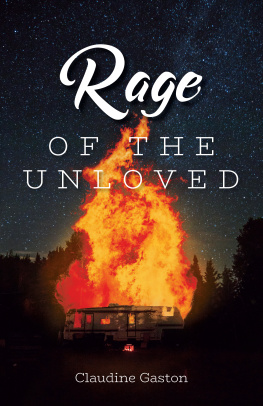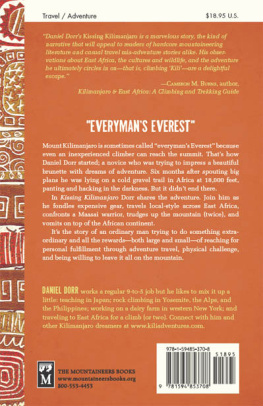About the 25 student and faculty authors who contributed to this book:
Interdependence and collaboration are essential to accomplish the goal of summiting Mt. Kilimanjaro. In a society that reveres individual accomplishment, climbing Kilimanjaro is an activity that cant be undertaken alone, in which the survival of every group member is dependent on their guides, porters, fellow hikers, and course instructors. Every chapter of this book illustrates vividly the power of this collaboration and the spectacular achievements that are possible by acknowledging and embracing the need for interdependence. This book provides a natural outgrowth of the experiences of the first class of college students at Elon University to take on the challenge of climbing the mountain while telling their story. The student authors constructed a narrative in the same way they undertook this journey: collectively, as a cohesive and interdependent team.
The student authors of this book are: Abby Fuller, Bailey Honig, Carson White, Cole Kocjancic, Daniela Nasser, Dara Sypes, Emma Renfro, Grace Jackson, Jack DiPietro, Junie Burke, Katherine Field, Kenneth Sklar, Konnor Porro, Liam Lindy, Meg Rude, Megan Barber, Morgan Collins, Nathan Jones, Neel Dhanani, Nik Streit, Tim Boles, and Victoria Baumgarten. Faculty authors include University President Dr. Connie Book, Primary Course Instructor Dr. Rodney Parks, Experiential Learning Faculty Dr. Carol Smith, and staff instructors Ms. Kelly Reimer and Ms. Kristen Aquilino. Finally, Dr. Diane Miller and Ms. Abby Fuller provided professional editing of the manuscript.
My dearest class, thank you for the memories we made during the inaugural class to hike to the top of Kilimanjaro. Im eternally grateful to each of you for being flexible and helping me to develop a wonderful class for future learners. Having a group of students write a guidebook for future hikers is a challenging process.
Special thanks to Abby Fuller for being the first person to read, edit, and organize the chapters of the manuscript, a very daunting task. Additionally, many thanks to Dr. Diane Miller, who served as a professional editor and reader of the manuscript. Diane, I cant thank you enough for always being willing to read my work (including my dissertation) and make the necessary suggestions to always strengthen my writing.
To my co-instructors, Kelly Reimer and Kristen Aquilino, I could not have made this class (or this book) happen without you. With each step on the trail you made a difference in the students we serve and I will be forever grateful for your willingness to endure the challenges of teaching the course. And to our Teaching Assistant, Nathan Jones, thank you for your leadership, tenacity, and willingness to push students to deeply engage in the experience.
Finally, to all those that were part of the journey and writing this book: Abby Fuller, Bailey Honig, Carson White, Cole Kocjancic, Daniela Nasser, Dara Sypes, Emma Renfro, Grace Jackson, Jack DiPietro, Junie Burke, Katherine Field, Kenneth Sklar, Konnor Porro, Liam Lindy, Meg Rude, Megan Barber, Morgan Collins, Nathan Jones, Neel Dhanani, Nik Streit, Tim Boles, Victoria Baumgarten, Kristen Aquilino, Kelly Reimer, Dr. Carol Smith, Janelle Papay Decato, and Dr. Connie Book.
Our journey began in a classroom on the second floor of Alamance Building at Elon University on May 2, 2019. Dr. Rodney Parks tried to prepare the 21 students who had registered for COR 331: Wilderness and Adventure Therapy. Expect the unexpected, Parks said as his students left the room, eight months out from attempting to summit the tallest freestanding mountain in the world.
Parks has led six groups of Elon students on trips to Peru for the study abroad component of his core capstone course. Taking students hiking on the Inca Trail and through the Rainbow Mountains is no simple task. Anytime you travel abroad, you risk routine illnesses such as flu and dysentery, but additional challenges that we face in Peru are how students are impacted by the physical components of the class and the impact of altitude. I always tell the students that you have to be comfortable being uncomfortable when it comes to hiking mountains at high altitude, Parks said.
Seemingly undaunted by these risks, Parks moved on to bigger peaks in 2018, when he began planning a class with the goal of summiting Mt. Kilimanjaro, the highest peak in Africa. Measuring in at 19,341 feet, the volcano towers over Tanzania and neighboring Kenya. Elon students have high levels of resilience and push themselves to make the most of their Elon experience. For the last couple of years I had wondered if we could take a class to do one of the famous Seven Summits, the highest mountains on each of the seven continents. Climbing to the summit of all of them is a mountaineering challenge that many strive to achieve in their lifetime, Parks said.
Parks, who has both a PhD in Counseling and a Master of Social Work, did not miss the opportunity to ask his Wilderness and Adventure Therapy students how they were feeling during that first meeting in May. Students were asked to describe their emotions in one word. The first 10 students used words emphasizing their courage and preparedness, like eager or excited, until one student shared how she really felt: scared.
I had never been into camping or hiking. The first time I went camping was over Fall Break, less than four months before leaving for Tanzania. And it was only for one night. So I really didnt know what I was getting myself into, Junie Burke, class of 20, reported. Burke wasnt alone in her fear. As the first Elon class to attempt to summit Kilimanjaro, we were trailblazers. Fear of the unknown plagued me in the months leading up to the climb: What if I went all the way to Tanzania and wasnt able to summit?
Parks decided to scope out the mountain on his own over the summer, to be able to answer students questions and relieve fears. I always make sure to visit any site that I intend to take students, to make sure we are well prepared to keep everyone safe on our journey, Parks said.
As Parks embarked on his climb sans students, the class began preparing for hiking by training and collecting gear. Hikers are expected to carry up to 20 pounds (lots of snacks and water) in their day packs, while porters carry all other gear and supplies. Some students practiced hiking with their packs before leaving for Kilimanjaro. I would take my pack to the gym and fill it with weights and hop on the stair climber and give it a shot. And the feeling of fear really motivated me, Burke said. There was almost a sense of urgency. I think I ended up being more physically prepared than I needed to be. Working out with other students who were preparing for the class really helped. Even though we were all a little nervous, if we were preparing together, wed be ready together.
Twenty pounds is heavy, but it is nothing compared to the nearly 50 pounds of gear and supplies each porter carries. Since 1991, the Tanzanian government has required all hikers of Kilimanjaro to be accompanied by a licensed guide. The travel company that hosted our class, Trekking Hero, supported our group of 24 hikers with 11 guides and 53 porters. We quickly found ourselves reliant on the guides and porters for meals, setting up our tents, and making it to camp safely each day.
Our guides became much more than our leaders through the wilderness, though. As they hiked with us, they became our teachers, our best opportunity for understanding the culture of the people who live around Kilimanjaro. Our class had only one day to experience life in Moshi, the town at the base of Kilimanjaro, before beginning the climb. That day was spent on a safari in Arusha National Park.
We drove to the park in safari trucks through areas inhabited by the Maasai tribe, and caught glimpses out the open windows of people dressed in bright patterned robes, herding livestock with long sticks. The rest of the day was spent on








